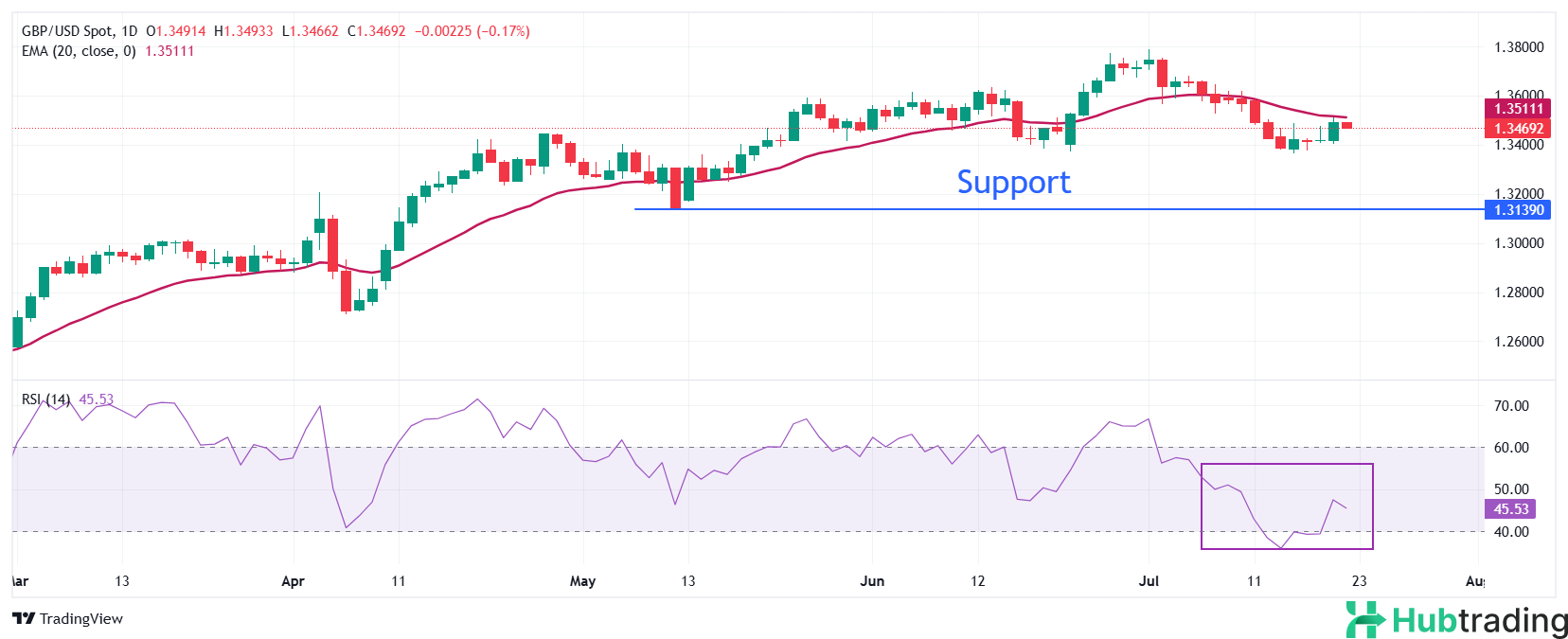-
Pound Sterling steadies near 1.3500 versus the US Dollar as markets await progress in US-EU trade negotiations.
-
President Trump weighs raising baseline tariffs on EU imports, heightening trade uncertainty.
-
Traders look ahead to the release of July's flash US S&P Global PMI data for further market direction.
The Pound Sterling (GBP) is treading water around 1.3500 against the US Dollar (USD) in Tuesday’s European session, slipping slightly as the Greenback steadies after Monday’s pullback.
The US Dollar Index (DXY) has found support just under 98.00, recovering modestly after retreating from last week’s four‑week peak near 99.00. Traders remain on edge ahead of the August 1 US tariff deadline, with Washington unlikely to finalize new bilateral deals before the cutoff.
So far, the US has struck agreements with the United Kingdom, Vietnam, Indonesia, and secured a limited pact with China. Letters outlining tariff schedules have already been sent to 22 countries—including Japan, Canada, Mexico, and the European Union—signaling tariff rates if no deal is reached.
US Treasury Secretary Scott Bessent emphasized on Monday that the administration is prioritizing the quality of trade deals over their timing, telling CNBC, “The important thing here is the quality of the deal, not the timing of the deals.”
A fresh flare‑up in US‑EU trade tensions could sway the dollar. EU officials have threatened retaliation should President Donald Trump move forward with tariffs, and The Wall Street Journal reported over the weekend that the White House is weighing a higher baseline tariff of 15–20%, up from the previously flagged 10%.
With the tariff deadline looming and flash US S&P Global PMI figures for July due later this week, volatility in GBP/USD is likely to intensify.
Daily Digest Market Movers: Pound Sterling Holds Steady Ahead of UK PMI and BoE Testimony
- The Pound Sterling (GBP) trades with a calm tone on Tuesday, maintaining stability against major currencies as market participants await the preliminary S&P Global Purchasing Managers’ Index (PMI) data for July, due Thursday. The release is expected to offer fresh insight into the UK’s economic health, especially amid signs of a hiring slowdown. Consensus forecasts suggest a minor dip in the UK Composite PMI to 51.9 from June’s 52.0, signaling continued but moderate business expansion.
- UK employers have been limiting new hires in response to higher labor costs, largely due to increased contributions to social security schemes. This trend has raised concerns about potential spillover effects on broader economic activity, which investors will watch for in the upcoming PMI figures.
- Attention is also turning to the Bank of England’s (BoE) next policy move. Markets widely anticipate a 25 basis point (bps) rate cut in August, which would bring the key interest rate to 4.00%. However, BoE Governor Andrew Bailey is not expected to offer much clarity on policy direction when he delivers testimony before the Treasury Select Committee at 09:15 GMT on Tuesday, regarding the Financial Stability Report.
- Across the Atlantic, investors are dialing back expectations for a Federal Reserve (Fed) rate cut in September. The shift follows last week’s hotter-than-expected US Consumer Price Index (CPI) data for June, driven in part by price increases on imported goods affected by former President Donald Trump’s sectoral tariffs.
Technical Outlook: GBP/USD Consolidates with Bearish Bias

The GBP/USD pair is hovering near 1.3470 on Tuesday, staying within Monday’s trading range. The short-term bias remains bearish, especially after the pair faced selling pressure from the 20-day Exponential Moving Average (EMA) around the 1.3500 mark.
Momentum indicators reflect weakness as the 14-day Relative Strength Index (RSI) struggles to hold above 40.00. A drop below this level would likely trigger fresh bearish momentum.
Key support is seen at the May 12 low of 1.3140, while resistance sits at the July 11 high of 1.3585.





